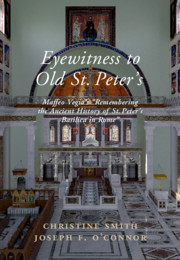 Eyewitness to Old St Peter's
Eyewitness to Old St Peter's Bibliography
Published online by Cambridge University Press: 03 July 2019
- Type
- Chapter
- Information
- Eyewitness to Old St Peter'sA Study of Maffeo Vegio's ‘Remembering the Ancient History of St Peter's Basilica in Rome,' with Translation and a Digital Reconstruction of the Church, pp. 285 - 300Publisher: Cambridge University PressPrint publication year: 2019


